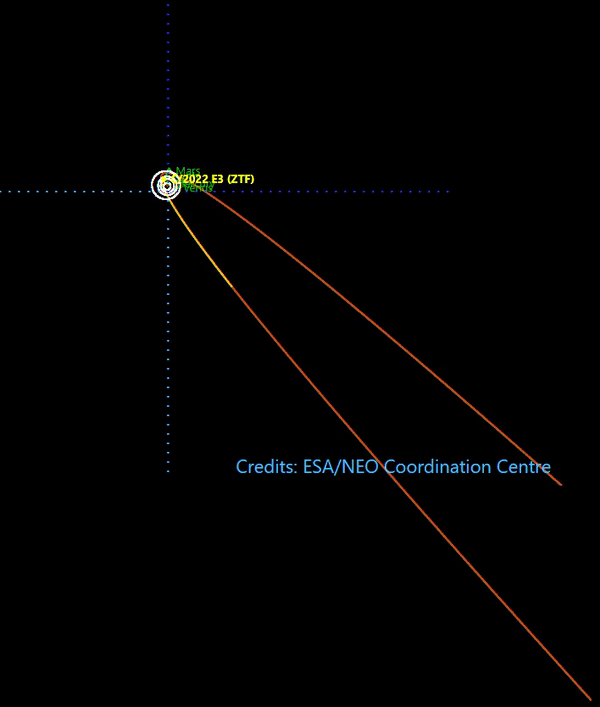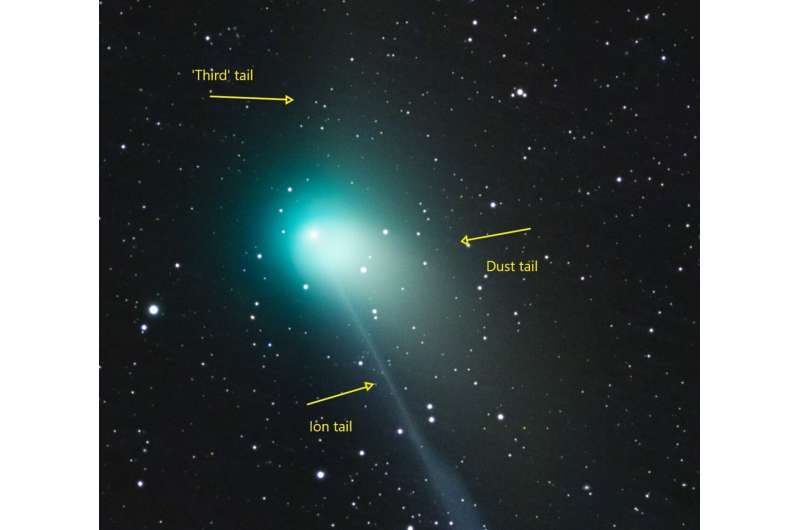Curious comet’s rare close approach

Comet C/2022 E3 (ZTF) today makes its closest approach to Earth before likely leaving our solar system forever. At billions of years old and not seen since Neanderthals roamed, the green comet continues to intrigue as it grows an apparent third tail and unexpectedly—but intriguingly—failed to wow scientists when observed in X-ray light.
Grab a pair of (good) binoculars and under dark skies look toward the celestial north pole over the next few days, for a chance to witness a beautiful piece of space history.
“All comets indeed give evidence … of a lot of bad luck, affliction, peril and danger,” wrote German author Thomas Hartmann in 1606, reflecting the fact that for a long time comets were deemed to be bad omens. Today, they are evidence of a lot, from the origin of the solar system to life on Earth.
“We know of almost four thousand ‘home-grown’ comets that formed, like the planets, in the leftover cloud of swirling gas and dust that fell in on itself to form our sun,” explains Marco Micheli, Astronomer in ESA’s Near-Earth Object Coordination Center.
“118 of these are currently classified as ‘near-Earth comets,’ and they’re being monitored closely as their orbit brings them across Earth’s own.”
Made up of dust, rock and ice, these “dirty snowballs” are the most pristine and untouched objects you can find, having changed very little over billions of years and so offering a window back to the forming of the solar system. It is also thought that at least some of the water on Earth originated in comets that impacted our planet in its early years.
Not only does their chemical composition reveal a great deal, but just 70 years ago the motion of their tails revealed the presence of the solar wind.
Supersonic solar wind
In the 1950s, inspired by discussions with colleagues on the nature of comet tails, the solar physicist Eugene Parker came up with the idea of a constant wind emanating from the sun.

At the time of Parker’s revelation, everyone thought the space between the planets in the solar system was almost empty. Parker’s idea was very controversial, not only because it meant that the sun could run out of mass, but also because his (correct) calculations meant the solar wind was supersonic.
As well as having tails, comets leave a trail of debris particles along their orbit that can span many millions of kilometers and linger for thousands, even millions of years.
As Earth orbits the sun, it frequently flies through this debris (also left by asteroids), and as the matter burns up in our atmosphere it “falls” creating regular meteor showers.
How many tails do you see?
Look closely, and you’ll spot that comets have two tails, one made of ionized gas and another of dust. As a comet approaches the inner solar system, solar radiation causes volatile materials within the comet to vaporize into gas and stream out of the nucleus—the comet’s “head”—carrying dust away with them.
In the dust tail, large grains scatter the sun’s light in all directions, some of which is detected by cameras and telescopes on Earth—like the moon and planets.
In the ion tail, molecules are much smaller but glow through a process called “fluorescence”: ionized atoms and molecules in the gas are struck by photons of light which they absorb, becoming “excited.” They then spontaneously re-emit photons at another wavelength, in a different color, depending on the molecule.
Comet ZTF’s bright green glow reveals the chemicals it is made up of, with dicarbon dominating emissions in this part of the visible spectrum.
“The two tails point in slightly different directions because the forces act on dust and ions in different ways. While the larger dust particles are pushed by pressure from sunlight, the ions are much lighter and electrically charged so are easily carried by the solar wind and its magnetic field,” explains Jorge Amaya from ESA’s Space Weather Office.
“Recently, a strange phenomenon has occurred with comet ZTF as it appears to have a third tail. This is, in fact, an optical illusion, due to our point of view of the dust trail.”

Disappointment to intrigue
Many ESA missions have been observing Comet ZTF, even those not focussed on solar system science. XMM-Newton is one of them, one of the most powerful X-ray telescopes ever placed into orbit.
Scientists had expected it to be one of the brightest comets observed, because of its bright green hue. Disappointingly at first, but then intriguingly, the comet barely showed up in the X-rays. While no stunning images were produced, the results are scientifically very valuable.
Science will continue, and there’s even a chance we’ll see Comet ZTF again up close and personal, as it is currently the most promising virtual target for ESA’s Comet Interceptor mission.
Try to see it
During close approach comet ZTF will appear near the north celestial pole, currently about ten degrees away from the bright star Polaris. By the end of this week, it will be more than 30 degrees from the North Star.
The best visibility will be with a good pair of binoculars, with which it should appear as a fuzzy colorless object, (only photographic cameras register its peculiar green color. If very lucky and under extremely dark skies, it will be visible with the naked eye.
Comets don’t pass by Earth very often, so catch Comet C/2022 E3 (ZTF) now, before it departs our solar system for good.
Citation:
Curious comet’s rare close approach (2023, February 1)
retrieved 1 February 2023
from https://phys.org/news/2023-02-curious-comet-rare-approach.html
This document is subject to copyright. Apart from any fair dealing for the purpose of private study or research, no
part may be reproduced without the written permission. The content is provided for information purposes only.
For all the latest Science News Click Here
For the latest news and updates, follow us on Google News.

